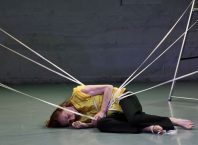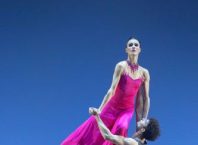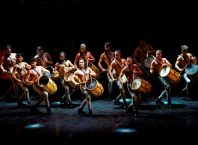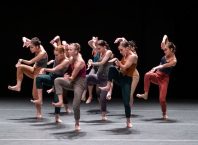Dancers, choreographers and a full house of interested spectators gathered last Friday afternoon at the Suzanne Dellal Theatre to see a presentation of the Summer Dance Workshop: Bridge – Choreographic Dialogues. Bridge is an exchange program that brings choreographers from Los Angeles to Israel to conduct two week intensive workshops and Israeli choreographers to UCLA for two weeks in the spring. Participating dancers have the opportunity to experience different approaches to dance. New this year was a choreographer’s workshop led by Shen Wei.
Now in its third year, Bridge was initiated by Miki Yerushalmi and is a joint project of the Tel Aviv-Los Angeles Partnership and the Jewish Federation of Greater Los Angeles, in cooperation with the Suzanne Dellal Centre, the UCLA Center for Intercultural Performance and Department of World Arts and Cultures, with the support of the Dance Department – Israeli Ministry of Culture and Sport and the U.S. Embassy – truly a cooperative international effort! “We began this program three years ago,” said Miki Yerushalmi, “the first year there were not many participants, and this year there were 90.” Most important for Yerushalmi is the continuity of cooperation and dialogue that takes place, as he says “people to people”, and the ongoing connection created between people and the institutions in both countries.
Dancers work with one choreographer for the two weeks in an intensive workshop, learning both technique and repertoire, acquiring a sense of the choreographer’s style and vision. The first group to perform worked with the bi-continental Israel/LA choreographer Barak Marshall, who taught them a fast-paced duet from his latest work “Monger.” Next up was Sheetal Ghandi, who said “I love coming here because in about 8 rehearsals I get to create a new work on hungry dancers.” Ghandi demonstrated for the audience the elements of Kathak, a North Indian form of dance that provides the basis for her creative work. There is a cycle of 16 counts, the movement phrase has to fit into that cycle and end on the second count of 1. Says Ghandi, “It’s a real mental challenge as well as a physical challenge.” The dancers who participated in Ghandi’s workshop performed a short, yet very accomplished dance that was an intriguing fusion of folk Indian elements with contemporary dance.
A hip-hop workshop was conducted by Jackie Lopez, who came to Israel for the first time in order to teach in the program. Lopez explained that there are many different styles of hip-hop, the style she chose to teach the group is called “house”. She chose it because it is a fusion of everything: salsa, mambo, rhumba and jazz; so that dancers new to hip-hop do not experience it as too foreign. Lopez explained her perspective on hip-hop, “Lots of hip-hop stands in one place I like the dancers to move across the floor. My hip-hop is set in the moment – what feels right. It’s not about the specific steps, but how to take the steps and put it together and make it a dance.” Her workshop participants proved they certainly learned how to use the space in an energetic piece with attitude.
Most intriguing was the presentation of the choreographer’s workshop where Shen Wei, worked with Israeli choreographers Katya Argov, Shlomi Frige, Shlomit Fundaminsky, and Dana Ruttenberg. A visual artist as well as dancer/choreographer, Shen Wei moved to the US from his native China in 1995, founding the Shen Wei Dance Arts Company in 2000. Winner of many grants and awards, including a MacArthur Foundation Fellowship in 2007, Shen Wei was invited to be the choreographer for the opening ceremonies of the Beijing Olympics. Eschewing a performance, Shen Wei offered the audience assembled at Suzanne Dellal on Friday something far more unusual – a glimpse into the intimacy of his studio as he demonstrated his individual work with the choreographers.
Shen Wei explained that he tried to work on “basic issues – how we place dancers onstage…little details that make the audience feel. The quality of movement like when you pick up a rock, how each movement has its own life, the life of movement itself. I don’t want their work to end up looking like my work. [I want] to keep them doing what they are doing, but do more…” There was a short presentation of each choreographer’s work accompanied by comments from Shen Wei and the choreographer. It was inspiring to see Shen Wei’s ability to identify the essential elements in each choreographer’s approach to his/her work and to find ways to develop their individual style while trying out new ways of working.
Listening to the workshop participants, one can find a common theme in their experience – a sense of Shen Wei’s underlying philosophy of movement as having a force and organic logic of its own. Shlomi Frige said that Shen Wei helped him “try to avoid the natural tendency to go to places that we know. I come from music and tend to use elements external to body language. Shen Wei wanted me to go to the movement from the movement, without anything from the outside.” Dana Ruttenberg said that she learned “that movement has a conclusion of itself that my brain is not aware of. [The brain can] initiate but then let go, leave the brain and go with the body. I realized that the movement itself is communicating something.”
Of Shlomit Fundaminsky, Shen Wei said, “Her movement is so powerful…I can watch her for hours.” Fundaminsky said that “Shen Wei transported me from the realm of performance to the realm of movement. I learned to respect the movement and its power, to trust in my language of movement. My movement is usually connected to some additional element. [He encouraged me to] simply bring the movement itself to the stage.”
Jackie Lopez took the stage showing that she not only talks the talk but knows how to move it. Although I am usually not as interested in dance forms such as hip-hop that have set predictable moves; I found Lopez’ interpretation of hip-hop refreshingly sensual and creative, her dance was not so much about the movements but the almost imperceptible, subtle transitions and transformations in between. Joining her in multicultural dialogue was Sheetal Ghandi and the two powerful women rocked the house. The afternoon presentation ended with a sneak preview of two short sections from “Rooster”, the new dance that Barak Marshall is creating for the Israeli Opera’s upcoming dance season.
Photo: Shen Wei with Shlomit Fundaminsky and Dana Ruttenberg






[…] “Each movement has its own life, the life of movement itself.” Shen Wei […]
[…] conducted a master class for choreographers last August at the Suzanne Dellal Centre as part of the Bridges – Choreographic Dialogues program. A celebrated dancer/choreographer, Shen Wei was born in China where he first performed with […]
[…] choreographers to identify the essential elements of their style. Read more about the exchange here. Shen Wei works with Israeli […]
Comments are closed.